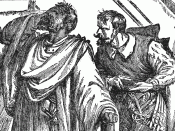This comparative essay focuses on the murder of Desdemona (Act V, Scene ii) of William Shakespeare's 'Othello', in both the Folger version of the play, and Oliver Parker's film adaptation of the play. Through omissions to the script, use of lighting, and added scenes, Oliver Parker alleviates Othello of guilt, and preserves his honour in his adaptation. This paper will examine the original play as performed in the Globe Theatre in the seventeenth century. In order to show the many changes made to this act when filmed, it will be detailed in order of scene additions, textual changes, and then lighting, which will tie back into scene additions at the end.
The most obvious difference between the Oliver Parker film adaptation, and Shakespeare's original play, is the use of camera angles. The Globe Theater was circular, with an audience occupying the circumference of the theatre. High paying audiences are seated up high (the highest paying seated at the high rear of the stage), and cheaper seats are sold down low, and surrounding the stage area (these people are known as the groundlings).
Because of the setup of the theatre, it is impossible for everyone to see everything in detail. If an important part of the scene is played out, it must be visible to the entire audience. Thus, small gestures and less visible scenes (which could be crucial moments to the play) could be missed entirely if used; and the opposite; grand scale cinematic scenes which would have also been impossible to perform on stage. Parker, however, did not suffer from these "minor" setbacks by today's standards. With the use of camera close-ups, and wide scenic footage he is able to add to his film adaptation a great deal more than the original could possibly provide for its audiences.
![From the Library of Congress: TITLE: Thos. W. Keene. Othello CALL NUMBER: POS - TH - 1884 .O7, no. 1 (C size) [P&P] REPRODUCTION NUMBER: LC-USZC6-58 (color film copy transparency) RIGHTS INFORMATION: No known restrictions on publication. MEDIUM: 1 print (](https://s.writework.com/uploads/9/94760/library-congress-title-thos-w-keene-othello-call-number-pos-thumb.jpg)

